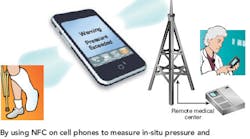The technology is based on an ultra-linear NFC microelectromechanicalsystems (MEMS) hybrid chip with 1-mm mercury (Hg) pressure-measurement precision and 0.1C temperature accuracy. It offers a pressure measurement range from -50 to +300 mm Hg while the orthopedic diagnostic range covers +20 to +40 mm Hg. The factory calibrated kit is fully programmable via cell phones or PCs. The internal battery can be recharged via a standard USB cable. Standard battery life is estimated at more than two weeks with a light-emitting-diode (LED) indicator showing battery life.
The kit uses exchangeable pressure probeseither saline or air. In addition, pressure probes smaller than 1 mm are available. An application-specific-integrated-circuit (ASIC) version can even be converted to Band-Aid format. Applications include monitoring of post-orthopedic surgery, back pressure and bed sores, and excessive pressure in casts (see figure). Other medical applications are under development.
The kit was developed during the past year by GENTAG and its partners under the specifications and medical guidance of a team of US orthopedic surgeons. That team was led by Dr. David Jacofsky, Chairman of The CORE Institute, and Dr. Roy Sanders, President of Florida Orthopedic Institute. The technology is covered under worldwide issued and pending patents.
The kit is already available for limited post-orthopedic-surgery trials. Commercial production is expected in 2012, starting first with pressure monitoring in casts. The technology will be fully compatible with Google, BlackBerry, Nokia, Samsung, and other brand NFC cell phones integrating the NFC chip. It also will be able to be bundled with low-cost, custom NFC cell phones (e.g., GENTAG's GT-601) as low-cost, hospital-discharge wireless-monitoring kits.

